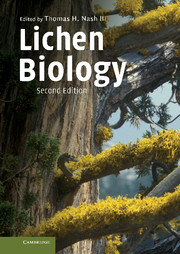Book contents
- Frontmatter
- Contents
- List of contributors
- Preface
- 1 Introduction
- 2 Photobionts
- 3 Mycobionts
- 4 Thallus morphology and anatomy
- 5 Morphogenesis
- 6 Sexual reproduction in lichen-forming ascomycetes
- 7 Biochemistry and secondary metabolites
- 8 Stress physiology and the symbiosis
- 9 Physiological ecology of carbon dioxide exchange
- 10 The carbon economy of lichens
- 11 Nitrogen, its metabolism and potential contribution to ecosystems
- 12 Nutrients, elemental accumulation, and mineral cycling
- 13 Individuals and populations of lichens
- 14 Environmental role of lichens
- 15 Lichen sensitivity to air pollution
- 16 Lichen biogeography
- 17 Systematics of lichenized fungi
- Appendix: Culture methods for lichens and lichen symbionts
- References
- Taxon index
- Subject index
12 - Nutrients, elemental accumulation, and mineral cycling
Published online by Cambridge University Press: 05 September 2012
- Frontmatter
- Contents
- List of contributors
- Preface
- 1 Introduction
- 2 Photobionts
- 3 Mycobionts
- 4 Thallus morphology and anatomy
- 5 Morphogenesis
- 6 Sexual reproduction in lichen-forming ascomycetes
- 7 Biochemistry and secondary metabolites
- 8 Stress physiology and the symbiosis
- 9 Physiological ecology of carbon dioxide exchange
- 10 The carbon economy of lichens
- 11 Nitrogen, its metabolism and potential contribution to ecosystems
- 12 Nutrients, elemental accumulation, and mineral cycling
- 13 Individuals and populations of lichens
- 14 Environmental role of lichens
- 15 Lichen sensitivity to air pollution
- 16 Lichen biogeography
- 17 Systematics of lichenized fungi
- Appendix: Culture methods for lichens and lichen symbionts
- References
- Taxon index
- Subject index
Summary
As with any organisms the accumulation and processing of both macronutrients and micronutrients essential for life's physiological functions are critical to the growth and development of lichens. The fact that lichens do not possess roots, the efficient nutrient absorption system of vascular plants, has led to major dependence on atmospheric sources of nutrients instead of the soil pool exploited by vascular plants (Nieboer et al. 1978), although some soil uptake by terricolous Peltigera species has been demonstrated (Goyal and Seaward 1982). Because atmospheric sources of nutrients are relatively meager compared with soil nutrient pools, nutrient concentrating mechanisms are critical for lichen survival. The fact that such mechanisms exist has led to more general scientific interest in lichens as surrogate receptors for atmospheric deposition. For example, the extremely high body burdens of radionuclides in indigenous human populations of arctic regions in the 1950s and 1960s resulted from their high consumption of caribou and reindeer, which in turn ate mostly lichens for 6–8 months of the year (Palmer et al. 1963; Lidén and Gustafsson 1967). Although most areas were remote from areas of surface nuclear testing, the lichens of these areas were efficient accumulators of radionuclides in this food chain. In more recent years, interest in such phenomena has led to using lichens for studies of regional atmospheric deposition of metals and other atmospheric contaminants (Puckett 1988).
- Type
- Chapter
- Information
- Lichen Biology , pp. 234 - 251Publisher: Cambridge University PressPrint publication year: 2008
- 20
- Cited by

